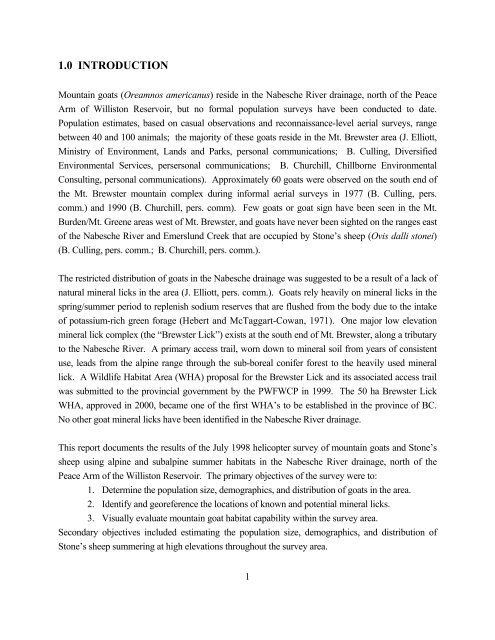Summer inventory of mountain goats and Stone's sheep ... - BC Hydro
Summer inventory of mountain goats and Stone's sheep ... - BC Hydro
Summer inventory of mountain goats and Stone's sheep ... - BC Hydro
Create successful ePaper yourself
Turn your PDF publications into a flip-book with our unique Google optimized e-Paper software.
1.0 INTRODUCTION<br />
Mountain <strong>goats</strong> (Oreamnos americanus) reside in the Nabesche River drainage, north <strong>of</strong> the Peace<br />
Arm <strong>of</strong> Williston Reservoir, but no formal population surveys have been conducted to date.<br />
Population estimates, based on casual observations <strong>and</strong> reconnaissance-level aerial surveys, range<br />
between 40 <strong>and</strong> 100 animals; the majority <strong>of</strong> these <strong>goats</strong> reside in the Mt. Brewster area (J. Elliott,<br />
Ministry <strong>of</strong> Environment, L<strong>and</strong>s <strong>and</strong> Parks, personal communications; B. Culling, Diversified<br />
Environmental Services, persersonal communications; B. Churchill, Chillborne Environmental<br />
Consulting, personal communications). Approximately 60 <strong>goats</strong> were observed on the south end <strong>of</strong><br />
the Mt. Brewster <strong>mountain</strong> complex during informal aerial surveys in 1977 (B. Culling, pers.<br />
comm.) <strong>and</strong> 1990 (B. Churchill, pers. comm). Few <strong>goats</strong> or goat sign have been seen in the Mt.<br />
Burden/Mt. Greene areas west <strong>of</strong> Mt. Brewster, <strong>and</strong> <strong>goats</strong> have never been sighted on the ranges east<br />
<strong>of</strong> the Nabesche River <strong>and</strong> Emerslund Creek that are occupied by Stone’s <strong>sheep</strong> (Ovis dalli stonei)<br />
(B. Culling, pers. comm.; B. Churchill, pers. comm.).<br />
The restricted distribution <strong>of</strong> <strong>goats</strong> in the Nabesche drainage was suggested to be a result <strong>of</strong> a lack <strong>of</strong><br />
natural mineral licks in the area (J. Elliott, pers. comm.). Goats rely heavily on mineral licks in the<br />
spring/summer period to replenish sodium reserves that are flushed from the body due to the intake<br />
<strong>of</strong> potassium-rich green forage (Hebert <strong>and</strong> McTaggart-Cowan, 1971). One major low elevation<br />
mineral lick complex (the “Brewster Lick”) exists at the south end <strong>of</strong> Mt. Brewster, along a tributary<br />
to the Nabesche River. A primary access trail, worn down to mineral soil from years <strong>of</strong> consistent<br />
use, leads from the alpine range through the sub-boreal conifer forest to the heavily used mineral<br />
lick. A Wildlife Habitat Area (WHA) proposal for the Brewster Lick <strong>and</strong> its associated access trail<br />
was submitted to the provincial government by the PWFWCP in 1999. The 50 ha Brewster Lick<br />
WHA, approved in 2000, became one <strong>of</strong> the first WHA’s to be established in the province <strong>of</strong> <strong>BC</strong>.<br />
No other goat mineral licks have been identified in the Nabesche River drainage.<br />
This report documents the results <strong>of</strong> the July 1998 helicopter survey <strong>of</strong> <strong>mountain</strong> <strong>goats</strong> <strong>and</strong> Stone’s<br />
<strong>sheep</strong> using alpine <strong>and</strong> subalpine summer habitats in the Nabesche River drainage, north <strong>of</strong> the<br />
Peace Arm <strong>of</strong> the Williston Reservoir. The primary objectives <strong>of</strong> the survey were to:<br />
1. Determine the population size, demographics, <strong>and</strong> distribution <strong>of</strong> <strong>goats</strong> in the area.<br />
2. Identify <strong>and</strong> georeference the locations <strong>of</strong> known <strong>and</strong> potential mineral licks.<br />
3. Visually evaluate <strong>mountain</strong> goat habitat capability within the survey area.<br />
Secondary objectives included estimating the population size, demographics, <strong>and</strong> distribution <strong>of</strong><br />
Stone’s <strong>sheep</strong> summering at high elevations throughout the survey area.<br />
1
















